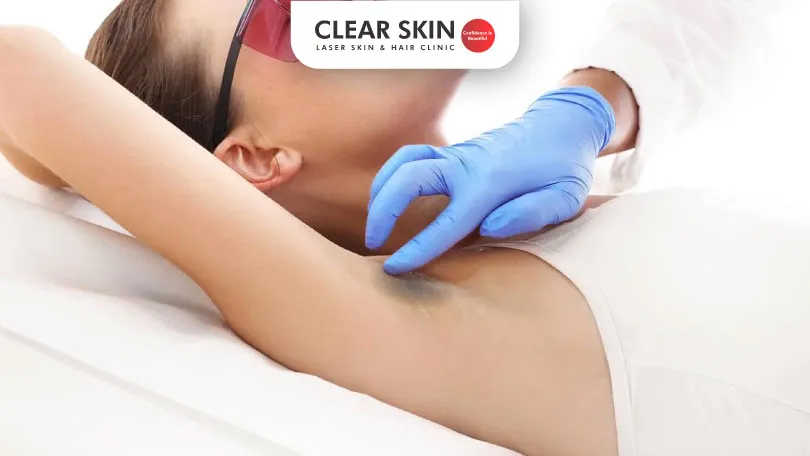- Home /
- Q&As
Q&As: Clear Skin Insights
Discover expert insights and solutions for clear, radiant skin in our comprehensive Acne Q&A page.

What is Best Treatment for Dark Underarms?
Seeking dark armpit solutions? Discover proven treatments to reduce underarm pigmentation and get clear skin confidence.
Tips for Fair and Glowing Skin for Oily Skin Types
Learn how glycolic acid and isotretinoin can help treat acne scars.
Why are my lips dark?
Dark lips can be caused by sun exposure, dehydration, smoking, or lifestyle factors. Understand the reasons and find expert solutions at Clear Skin Clinic, Pune.
How to Reduce Melanin Production in Skin Naturally?
Diet plays a good role to decrease melanin in your body.
How to Remove Black Scars on legs?
If you’re dealing with black scars on your legs, it’s likely due to conditions like folliculitis caused by ingrown hairs from waxing. Laser hair removal offers a permanent solution by destroying hair follicles, reducing future ingrown hairs.
Unlocking the Secrets of Acne Treatment Costs in Pune: Your Go-To Guide!
Curious about acne treatment costs in Pune? Learn about laser treatments, session prices, influencing factors, and insurance tips.
Understanding and Managing Chest and Back Acne
Do you know what causes pimples on the chest and back? Click to Know more
What is Best Treatment for Keloid Removal?
Home / Q&As / What is Best Treatment for Keloid Removal?What is Best Treatment for Keloid Removal?Reviewed By: Dr Dhanraj ChavanUpdated on: 26th February, 2024Keloids are firm, rubbery lesions resulting from an overgrowth of granulation tissue at a healed skin...
How much does chicken pox scar removal cost ?
Home / Q&As / How much does Chicken Pox Scar Removal Cost ?How much does Chicken Pox Scar Removal Cost ?Reviewed By: Dr Dhanraj ChavanUpdated on: 3rd April,2023Chickenpox often leaves behind scars that can persist for years. Treatment for these scars varies based...
How to Remove Acne Marks?
Home / Q&As / How to Remove Acne Marks?How to Remove Acne Marks? Reviewed By: Dr Dhanraj ChavanUpdated on: 1st July, 2024Co2, Q-switch laser, Chemical peeling & topical application of medications helps also in fading the marks and achieving good results.Table...
How much do Chemical Peels for Acne Scars Cost?
Home / Q&As / How much do Chemical Peels for Acne Scars Cost?How much do Chemical Peels for Acne Scars Cost?Reviewed By: Dr Dhanraj ChavanUpdated on: 24th June, 2024Understanding the cost of treating acne and acne scars depends on the specific type and severity...
How can I Remove my Dark Circles?
Home / Q&As / How can I Remove my Dark Circles?How can I Remove my Dark Circles?Reviewed By: Dr Dhanraj ChavanUpdated on: 17th June, 2024Dark circles are a non-hormonal skin condition affecting both men and women, commonly seen in teenagers as well. The primary...
What is Chicken Pox Scar Removal Cost?
Home / Q&As / Chicken Pox ScarsWhat is Chicken Pox Scar Removal Cost?Reviewed By: Dr Dhanraj ChavanUpdated on: 3rd June, 2024 Chickenpox scars are a common concern for those who have experienced this viral infection, as they can leave lasting marks on the skin....
What is the Best Treatment for Melasma?
Home / Q&As / What is the Best Treatment for Melasma?What is the Best Treatment for Melasma?Reviewed By: Dr Dhanraj ChavanUpdated on: 27th May, 2024Melasma is a common skin condition characterized by blotchy, brownish facial pigmentation, more prevalent in women...
Moles/Nevus
Home / Q&As / Moles/NevusMoles/NevusReviewed By: Dr Dhanraj ChavanUpdated on: 13th May, 2024Worried about moles? Dr. Dhanraj Chavan explains laser mole removal. For top skin care in Pune, book an appointment with our dermatologists at +919584584111.Table Of...
Why Do I Get Acne During Pregnancy
Q&As / Acne during pregnancyWhy Do I Get Acne During Pregnancy?Reviewed By: Dr Dhananjay chavanCategory: Acne, Acne in adulthoodThis puzzling occurrence can be attributed to a combination of factors related to hormonal fluctuations, immune system changes, and...
Didn’t Find What You Were Looking?
Please Contact Us.
We are committed not only to treating you, but also educating you.

